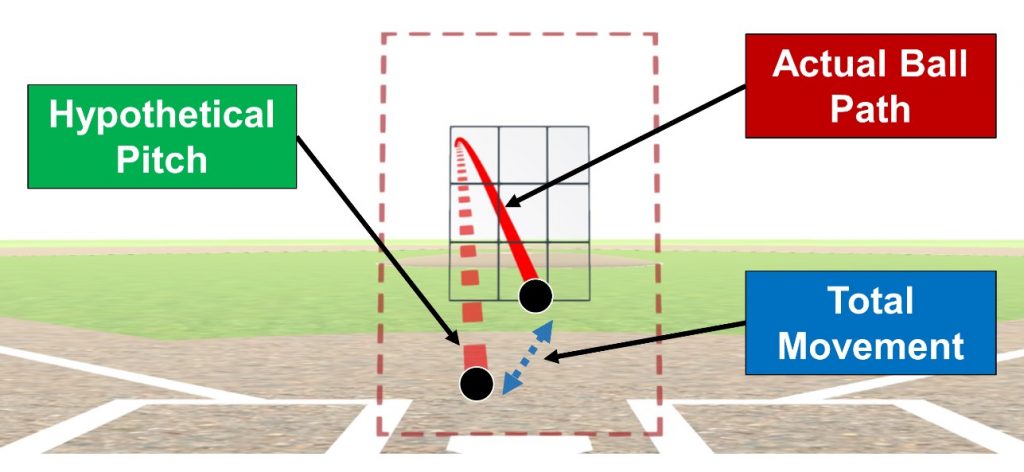
Choosing The Correct Pitch Seqences stands as a fundamental skill crucial for any pitcher who aspires to excel in the game of baseball. It is characterized by a thoughtful combination of different pitch types, speeds, and locations, all strategically employed to confound the batter and gain the upper hand in the game. This method is about much more than just throwing; it's about throwing with purpose and intelligence.
The journey to mastering pitch sequencing begins with a deep understanding of one’s own pitching arsenal. Pitchers must be intimately familiar with each type of pitch they can throw—be it the fastball, known for its speed and direct path; the breaking ball, which deceives with its unexpected changes in direction; or the changeup, which disrupts the batter's timing with its slower velocity compared to the fastball.
Each pitch type serves a unique function and, when used correctly, contributes to a well-rounded and effective pitching strategy. The fastball, often used to set the tone and control the pace of the encounter, establishes dominance and can be used to set up more nuanced pitches. Breaking balls, which include curveballs and sliders, add an element of unpredictability, perfect for countering batters who have started to time the fastball. Changeups serve as the perfect foil to fastballs, keeping batters off balance and guessing wrong about the speed of the pitch.
By recognizing and understanding the diverse effects of these pitches, a pitcher can begin to craft sequences that leverage their strengths, exploit the hitter's weaknesses, and adjust to the game's context. This nuanced approach allows pitchers to keep hitters guessing and off balance, maximizing their effectiveness and dominance on the mound.
Self-Assessment of Pitch Arsenal: Choosing The Correct Pitch Seqences
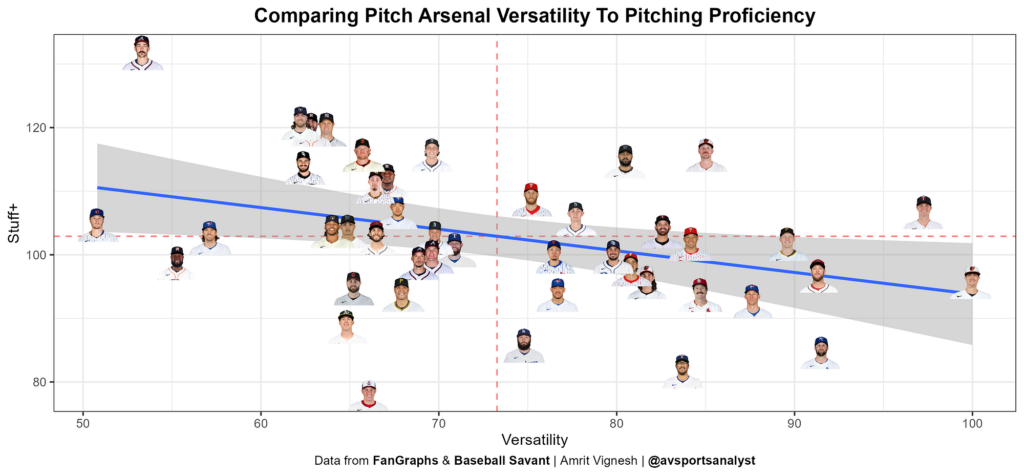
For pitchers aiming to excel in baseball, a critical initial step is conducting a thorough self-assessment of their pitch arsenal. This introspective analysis involves evaluating the strength, effectiveness, and reliability of each type of pitch they possess. Understanding one's capabilities and limitations allows a pitcher to develop a personalized pitching strategy that capitalizes on their strengths while mitigating their weaker areas.
For instance, a pitcher blessed with a high-velocity fastball has a powerful tool at their disposal. This pitch can be a game-changer, setting a strong, aggressive tone right from the start. By establishing the fastball early in the count, the pitcher not only exerts control over the batter but also sets up the strategic use of subsequent pitches. The fastball serves as a foundation upon which the pitcher can build their sequence.
Once the fastball has been established and the batter's timing is tuned to this speed, introducing slower, off-speed pitches becomes an effective tactic. Changeups and curveballs, which are significantly slower and have different movement patterns compared to fastballs, can be particularly disorienting for the batter. When a batter is primed to expect another fastball, the sudden drop in speed and change in trajectory can lead to premature swings and misses or weak, poorly timed hits.
Moreover, by using the fastball to dictate the pace and rhythm of the encounter, the pitcher gains psychological and tactical advantages. This control allows them to manipulate the game's dynamics, forcing batters into defensive positions and making it challenging for them to execute their game plan effectively.
In essence, the self-assessment of a pitcher's arsenal is not just about knowing what pitches they can throw; it's about understanding how to intelligently integrate these pitches into a cohesive strategy that maximizes their strengths and keeps batters guessing and off-balance throughout the game. This strategic layer of pitching is what separates competent pitchers from truly dominant ones on the mound.
Situational Awareness in Pitching: Choosing The Correct Pitch Seqences
 Situational awareness is a pivotal aspect of effective pitch sequencing, enabling pitchers to tailor their approach based on the specific context of the game and the characteristics of the batter at the plate. This level of strategic thinking involves not only a deep understanding of the game’s dynamics but also a keen ability to read and react to the nuances of each batting encounter.
Situational awareness is a pivotal aspect of effective pitch sequencing, enabling pitchers to tailor their approach based on the specific context of the game and the characteristics of the batter at the plate. This level of strategic thinking involves not only a deep understanding of the game’s dynamics but also a keen ability to read and react to the nuances of each batting encounter.
To excel in situational pitching, a pitcher must be adept at analyzing the tendencies and weaknesses of each batter. For instance, a power hitter known for hitting home runs might also have a propensity to chase breaking balls that veer outside the strike zone. Recognizing this vulnerability allows the pitcher to strategically employ pitches that are likely to elicit a poor response from the batter. By throwing a curveball or slider that starts in the strike zone and then breaks outward, the pitcher can tempt the batter into making a premature and ineffective swing, potentially leading to a strikeout or an easy out.
Moreover, situational awareness extends beyond individual batters to encompass the overall game scenario. Pitchers must consider factors such as the number of outs, the positions of base runners, the inning, and even the score. Each of these elements influences the choice of pitches. For example, in a close game with runners on base and fewer outs, a pitcher might opt for pitches that are more likely to induce ground balls to initiate double plays. Similarly, when facing the bottom of the batting order, a pitcher might be more aggressive with pitches within the strike zone, taking advantage of the generally weaker hitters to gain quick outs.
Crafting an effective pitch sequence also involves anticipation and adaptability. Pitchers must be prepared to adjust their strategy based on the ongoing developments in the game. If a particular batter adjusts their stance or swing in response to previous pitches, a smart pitcher will notice these adjustments and modify their sequence accordingly, perhaps by introducing an unexpected pitch or altering the location of their throws.
In essence, situational awareness in pitching is about merging strategic analysis with tactical execution. It demands that pitchers not only know their own strengths and the typical responses of batters but also remain flexible and responsive to the fluid nature of the game. By mastering this, pitchers can significantly enhance their effectiveness, turning each pitch into an opportunity to outsmart the opponent and tilt the game in their favor.
The Art of Pitch Sequencing: Strategic Planning Against Batters
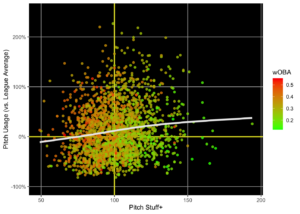 Effective pitch sequencing transcends the simple alternation of pitch types; it is an art form that melds deep strategic insight with the element of deception. Mastery of this craft involves not only a profound understanding of one’s own pitching capabilities but also a detailed knowledge of the opposing team's lineup and each batter's history and vulnerabilities.
Effective pitch sequencing transcends the simple alternation of pitch types; it is an art form that melds deep strategic insight with the element of deception. Mastery of this craft involves not only a profound understanding of one’s own pitching capabilities but also a detailed knowledge of the opposing team's lineup and each batter's history and vulnerabilities.
The process begins with meticulous preparation and analysis. Prior to a game, pitchers, along with their coaches and analysts, invest time in studying video footage, scouting reports, and statistical data on batters. This research helps to map out a comprehensive profile for each hitter: their strengths, weaknesses, preferred pitch types, and performance trends. For instance, a batter known to struggle with high fastballs presents a tactical opportunity. A pitcher who can deliver a fast, high pitch with precision might use this knowledge to set up the batter with lower pitches initially, building the expectation for more of the same, only to disrupt the pattern with a sudden high fastball.
This strategic planning is about creating a sequence of pitches that plays mind games with the batter. The objective is to exploit the batter's preconceived notions and mechanical tendencies. If a batter is expecting a certain type of pitch in a particular count based on previous at-bats, the pitcher can use this anticipation against them, delivering something unexpected to induce a mistake.
Moreover, the art of pitch sequencing involves adjusting the strategy in real-time. A batter's approach can change depending on the game situation, such as the difference in their swings when they are ahead or behind in the count, or when runners are on base. Effective pitchers observe these adjustments and tweak their pitch sequence accordingly. This might mean changing the type of pitch or altering the location slightly to keep the batter off-balance and unsure of what will come next.
In practice, the art of pitch sequencing is as much about psychology as it is about physical skill. It's about understanding the mental game between pitcher and batter—anticipating thoughts, triggering reactions, and controlling the pace and flow of the confrontation. Each pitch is a question posed to the batter, and each swing (or lack thereof) provides an answer that informs the next move in this high-stakes chess game. By mastering this dynamic interplay, pitchers can effectively dominate the diamond, turning their deep strategic planning into tangible results on the field.
Mixing Pitches for Optimal Effect: Choosing The Correct Pitch Seqences
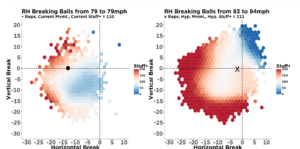 The strategy of varying pitch types, speeds, and locations is central to disrupting a batter's timing and rhythm at the plate. This tactic is not merely about diversity in selection but about integrating these variations into a cohesive strategy that keeps hitters perpetually uncertain and reactive rather than proactive. However, the effectiveness of this approach hinges on the pitcher's ability to maintain a delicate balance between deception and control.
The strategy of varying pitch types, speeds, and locations is central to disrupting a batter's timing and rhythm at the plate. This tactic is not merely about diversity in selection but about integrating these variations into a cohesive strategy that keeps hitters perpetually uncertain and reactive rather than proactive. However, the effectiveness of this approach hinges on the pitcher's ability to maintain a delicate balance between deception and control.
To successfully mix pitches, a pitcher needs to have a profound command over each type of pitch in their arsenal. It's not enough to simply throw a curveball or a slider; these pitches must be executed with precision and must fit logically into the broader game plan. For instance, a well-placed fastball can set up an off-speed pitch like a changeup. The stark contrast in speed can cause the batter to swing early and miss if they are anticipating another fastball, thus exploiting their disrupted timing.
However, while deception is a valuable tool, it should not come at the cost of a pitcher's control and comfort. Striking this balance is crucial. A pitcher must feel confident in their ability to throw each pitch in any given situation. If a pitcher is uncomfortable with a particular pitch but throws it purely for the sake of unpredictability, this can lead to poor execution. Poor execution not only reduces the effectiveness of the pitch but can also lead to costly mistakes, such as walks or easily hittable pitches that turn into runs against.
Furthermore, pitchers need to be aware of their own body mechanics and ensure that their efforts to vary pitches do not lead them to telegraph their intentions. Subtle differences in wind-up or release point between different pitches can be picked up by experienced batters and used to anticipate the type of pitch being thrown. Thus, maintaining a consistent delivery across all pitch types is as important as the pitches themselves.
Ultimately, the goal of mixing pitches is to weave a tapestry of uncertainty for the batter, making it difficult for them to predict what will come next. This requires not only physical skill in delivering a variety of pitches but also a mental sharpness to strategize effectively without overcomplicating one's approach. By mastering this balance, pitchers can keep hitters off-balance while maintaining their dominance and efficacy on the mound.
Advanced Pitch Sequencing Techniques: Utilizing Pitch Tunneling and Manipulation
In the advanced realm of pitching, techniques like pitch tunneling and tunnel manipulation stand out as sophisticated strategies that elevate a pitcher's game. These methods are not just about throwing harder or more accurately but involve a deep psychological and physiological manipulation of the batter's perception and reaction.
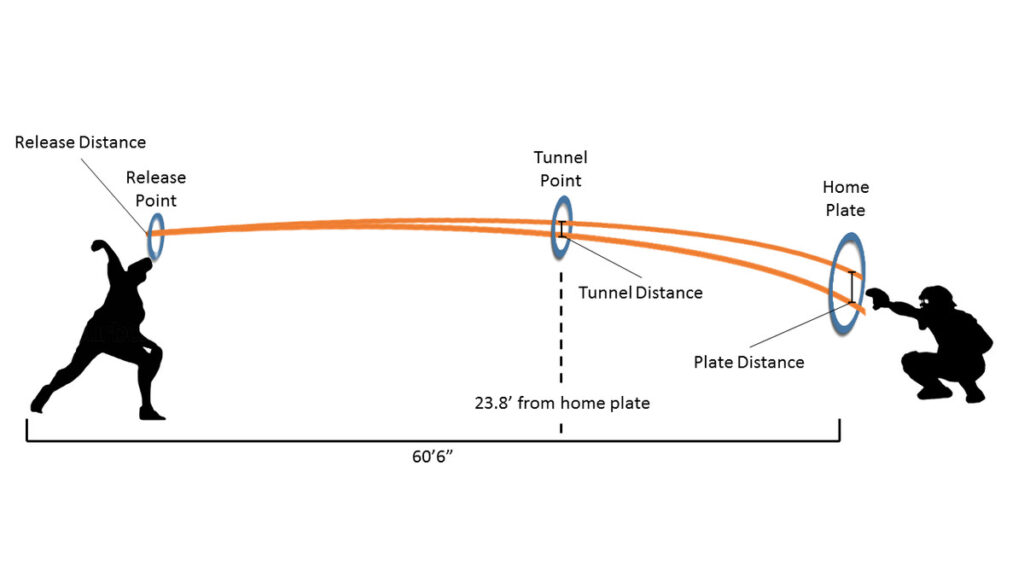
Pitch Tunneling Explained: Choosing The Correct Pitch Seqences
Pitch tunneling is a technique where a pitcher makes several different pitches appear identical as they travel toward the plate for most of their trajectory. This is achieved by maintaining the same arm angle and release point for a fastball, a slider, and a changeup, for example. To the batter, all pitches seem to be on the same path, making it exceedingly difficult to identify what pitch is coming until it's too late. Only at the last moment do these pitches diverge in speed and movement, leading to hesitation and often poor decision-making by the batter. The key to successful pitch tunneling lies in the pitcher's ability to execute different pitches with nearly identical initial trajectories.
The Art of Tunnel Manipulation
Tunnel manipulation takes the concept of pitch tunneling a step further by introducing slight variations in the pitch's flight path mid-trajectory. This technique involves subtle shifts in the pitch's speed or spin that alter its final destination just as the batter needs to make a swing decision. For instance, a pitcher might throw a curveball that starts on a fastball's trajectory but then breaks sharply. This sudden, unexpected change forces the batter to commit based on the initial trajectory, only to be fooled as the pitch breaks differently.
Tunnel manipulation is particularly effective because it plays directly on the batter's built-in expectations and split-second judgment. By altering the pitch mid-flight, the pitcher adds an extra layer of deception, greatly complicating the batter's task of timing and hitting the ball. It requires exquisite control and an in-depth understanding of how subtle variations in pitch mechanics affect movement and perception.
Integrating Advanced Techniques
To integrate these advanced techniques effectively, pitchers must have a robust foundation in the mechanics of each pitch and an acute awareness of how slight changes affect the ball's path. They also need to be astute observers of batters' habits and tendencies. This observational skill allows pitchers to tailor their approach to exploit specific weaknesses or tendencies in the batting lineup.
Moreover, the use of high-tech tools like high-speed cameras and spin rate analyzers in training can help pitchers refine their tunneling and manipulation skills. These technologies provide detailed feedback on the flight characteristics of each pitch, allowing pitchers to make precise adjustments to their technique.
Conclusion: Choosing The Correct Pitch Seqences
Advanced pitch sequencing techniques like tunneling and manipulation represent the cutting edge of pitching strategy. These methods require not only physical skill and precision but also a high degree of tactical intelligence. For pitchers who master these techniques, the payoff is significant, often resulting in increased strikeout rates and reduced hitting success for opponents. As such, these advanced strategies are essential tools for any pitcher looking to dominate at higher levels of baseball.
In-Game Adjustments and Deception: Choosing The Correct Pitch Seqences
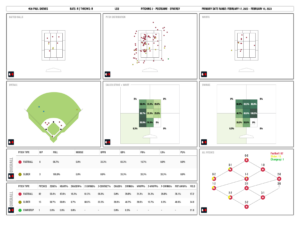 The dynamic nature of baseball demands that pitchers not only come into the game with a well-prepared strategy but also remain adaptable, making in-game adjustments based on the evolving conditions and responses of the batters. This ability to modify tactics on the fly is crucial for maintaining effectiveness throughout the game. Additionally, integrating deception techniques further complicates the batter's task, enhancing the pitcher's control over the game's outcome.
The dynamic nature of baseball demands that pitchers not only come into the game with a well-prepared strategy but also remain adaptable, making in-game adjustments based on the evolving conditions and responses of the batters. This ability to modify tactics on the fly is crucial for maintaining effectiveness throughout the game. Additionally, integrating deception techniques further complicates the batter's task, enhancing the pitcher's control over the game's outcome.
Observing and Reacting to Batter Adjustments
A key aspect of in-game adjustments involves closely observing how batters respond to different pitches. A pitcher might notice, for example, that a batter is starting to time the fastball better after seeing a few during the game. This observation could prompt the pitcher to change up the sequence, perhaps introducing more off-speed pitches like changeups or sliders to disrupt the batter’s timing.
Conversely, if a pitcher sees that a batter is struggling with breaking balls, they might increase the frequency of curveballs and sliders thrown to that particular batter. It's this kind of strategic flexibility that can make the difference between a successful outing and a challenging one.
Deceptive Tactics to Enhance Effectiveness
Deception plays a critical role in pitching, serving to keep the batter guessing and off balance. One effective method of deception is varying arm angles. By altering the angle of release, a pitcher can change the perceived trajectory of the ball, making it more difficult for the batter to track the pitch. For instance, a sidearm delivery can add an unexpected horizontal movement to pitches, which might be especially disorienting if the batter has been facing overhand pitches all game.
Adjusting delivery speeds is another powerful tactic. A pitcher who can effectively change their tempo between pitches can disrupt a batter’s timing significantly. This could mean varying the speed of the pitch itself or altering the rhythm of the pitching motion. Sometimes, just a slight delay or quickening of the delivery can be enough to throw off a batter’s swing timing.
Strategic Use of Pitch Location
Another aspect of in-game adjustments involves the strategic placement of pitches. Pitchers can use location to their advantage by throwing pitches outside the usual strike zone in anticipation of the batter swinging at anything close with two strikes, or by targeting a known weak spot in a batter's swing. For example, if a batter consistently fails to connect with pitches low and away, a pitcher might focus more on that area, especially in critical count situations.
Integrating Feedback and Continuous Adaptation
Successful pitchers also integrate feedback from their catchers and pitching coaches, who can offer insights from a different viewpoint or notice things that the pitcher might miss from the mound. This collaboration helps refine the approach throughout the game, allowing for more precise adjustments and strategic decisions.
Conclusion: Choosing The Correct Pitch Seqences
In-game adjustments and the strategic use of deception are essential for pitchers looking to maintain dominance over batters. By staying observant, adaptable, and employing a variety of deceptive techniques, pitchers can significantly enhance their effectiveness, keeping batters unsure and uncomfortable at the plate. This dynamic interplay of strategy, observation, and adaptation is what defines the art of pitching at the highest levels of baseball.
Scenario-Specific Sequencing Strategies: Adapting to Game Situations
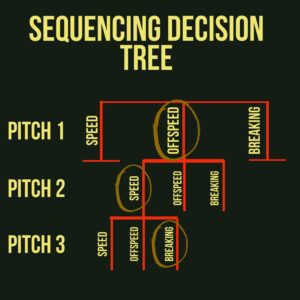 In the complex game of baseball, the ability to adapt pitch sequencing to the specific scenarios that arise during a game is crucial for a pitcher's success. This adaptive approach ensures that pitchers can maintain control and leverage under varying circumstances, from count-specific strategies to inning-by-inning adjustments. Understanding the nuances of different game situations and tailoring pitches accordingly can make the difference between a win and a loss.
In the complex game of baseball, the ability to adapt pitch sequencing to the specific scenarios that arise during a game is crucial for a pitcher's success. This adaptive approach ensures that pitchers can maintain control and leverage under varying circumstances, from count-specific strategies to inning-by-inning adjustments. Understanding the nuances of different game situations and tailoring pitches accordingly can make the difference between a win and a loss.
Count-Specific Pitch Sequencing
One of the first areas where scenario-specific strategies come into play is in count-specific pitching. When ahead in the count, pitchers have the freedom to throw pitches that might be riskier, such as breaking balls or off-speed pitches that might entice a batter to swing at a pitch outside of the strike zone. Conversely, when behind in the count, a pitcher might rely on their most accurate pitch to avoid walking the batter, often resorting to fastballs or pitches they feel most confident throwing for strikes.
Inning-Specific Approaches
As the game progresses, the strategy may also shift based on the inning. Early in the game, pitchers might focus on establishing a variety of pitches to gauge the batters' responses and set the tone for later innings. In the middle innings, depending on the score and the performance of the opposing team, a pitcher might begin to implement more strategic pitches aimed at inducing specific types of contact, like ground balls or flyouts, to manage the opposing lineup effectively. Late in the game, especially if the pitcher is still in during closing situations, the approach might shift towards using strikeout pitches or very conservative pitches to protect a lead.
Tailoring Pitches to the Batter Type
Another critical aspect of scenario-specific sequencing is tailoring pitches to the type of hitter at the plate. Power hitters and contact hitters present very different challenges and require different approaches. For power hitters, pitchers might use more off-speed pitches and breaking balls to exploit the batter's aggression and tendency to go for big hits, which increases the chances of strikeouts or mis-hits. Against contact hitters, who typically have good bat control and make frequent contact, pitchers might use pitches with more movement or locate pitches more precisely on the edges of the strike zone to induce weak contact or playable ground balls.
Game Situation Adaptations
Game situations such as runners on base also dictate adjustments in pitch sequencing. With runners on base, especially in scoring positions, pitchers might opt for pitches that are more likely to result in ground balls to induce double plays or prevent the ball from being hit into deep outfield. The pressure of these situations also might influence a pitcher to rely on their most dependable pitches, reducing the risk of errors or wild pitches that could allow runners to advance.
Continuous Adaptation and Collaboration
Effective scenario-specific pitching requires continuous adaptation and often a collaborative effort between the pitcher, catcher, and coaching staff. The catcher, in particular, plays a vital role, offering insights based on their unique perspective and direct interaction with the batter's reactions. This collaboration helps refine the pitching strategy in real-time, ensuring that the pitcher remains flexible and responsive to the immediate demands of the game.
Conclusion: Choosing The Correct Pitch Seqences
Adapting pitch sequencing based on the game's context is an advanced skill that distinguishes top pitchers in baseball. By effectively adjusting their approach to suit different counts, innings, batter types, and game situations, pitchers can maximize their effectiveness and maintain a competitive edge throughout the game. This strategic adaptability not only helps in managing the immediate challenges but also in setting up for long-term success over the course of a game or season.
Evaluating and Enhancing Pitch Sequencing: Leveraging Analytics and Technology
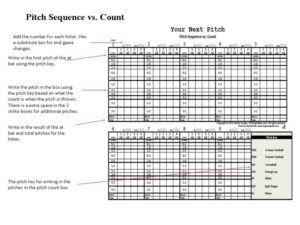 In the modern era of baseball, the use of analytics and technology has become integral to refining and enhancing a pitcher's approach to the game. By leveraging sophisticated analytics and cutting-edge technology, pitchers and their coaches can evaluate the effectiveness of pitch sequencing with remarkable precision, leading to more informed strategic decisions and improvements in performance.
In the modern era of baseball, the use of analytics and technology has become integral to refining and enhancing a pitcher's approach to the game. By leveraging sophisticated analytics and cutting-edge technology, pitchers and their coaches can evaluate the effectiveness of pitch sequencing with remarkable precision, leading to more informed strategic decisions and improvements in performance.
Utilizing Advanced Analytics
Advanced analytics play a crucial role in dissecting every aspect of a pitcher's performance. Metrics such as spin rate, exit velocity, pitch velocity, and ball movement provide a quantitative foundation for assessing the effectiveness of different pitches and sequences. These data points allow pitchers and coaches to analyze trends and patterns that may not be visible to the naked eye. For example, analytics can reveal if a pitcher's slider is losing its effectiveness later in the game or if a particular sequence tends to yield higher strikeout rates against certain types of batters.
By examining these metrics, pitchers can identify which elements of their approach are working and which areas may require adjustments. This could involve tweaking a grip to improve spin rate or altering the timing between pitches to disrupt the batter’s rhythm more effectively.
Employing Pitch Tracking Systems
Pitch tracking systems such as TrackMan or Rapsodo provide detailed insights into the trajectory and dynamics of each pitch. These systems track the complete path of the ball from the pitcher's hand to the catcher's mitt, offering valuable data on pitch location, speed, break, and overall effectiveness. This information is vital for understanding how each pitch performs in actual game situations and how hitters are responding to different types of pitches.
For instance, if data shows that a pitcher’s curveball is consistently being hit when thrown in certain counts, the pitcher might adjust when and where they use that pitch in their sequence. Alternatively, if the tracking data shows that batters often miss a high fastball after seeing several breaking balls, the pitcher can use this pattern to their advantage.
Integrating Video Analysis
Video analysis tools also complement physical and data-driven analytics by allowing pitchers to visualize their mechanics and the batter's reactions in real time. Slow-motion and frame-by-frame review can help identify small inconsistencies in delivery or show how slight changes in pitch release points might affect the pitch's effectiveness.
This visual feedback is invaluable for making precise adjustments, such as ensuring the pitcher maintains a consistent arm angle across all pitch types or correcting a tendency to tip pitches by varying delivery subtly.
Feedback Loops and Continuous Improvement
One of the significant advantages of using analytics and technology in baseball is the ability to establish a continuous feedback loop. Pitchers can test adjustments in real-world settings, gather data on the outcomes, and refine their approach accordingly. This iterative process promotes ongoing improvement and adaptation, which is crucial in a sport where small margins can determine the success or failure of a pitcher.
Collaboration with Coaches and Analysts
Finally, the effective use of analytics and technology often involves collaboration between the pitcher, pitching coaches, and data analysts. This team approach ensures that data interpretation and strategy adjustments are well-informed and targeted to specific needs. Coaches can provide the tactical expertise and experiential insight to interpret data correctly, while analysts can handle the technical aspects of data gathering and pattern identification.
Conclusion: Choosing The Correct Pitch Seqences
Leveraging analytics and technology to evaluate and enhance pitch sequencing represents a forward-thinking approach to baseball strategy. By embracing these tools, pitchers can gain deeper insights into their performance, enabling them to make smarter, data-driven adjustments that refine their pitch sequencing and enhance their overall effectiveness on the mound. This marriage of technology and traditional baseball acumen is reshaping how pitchers prepare for and excel in games.
FAQs: Choosing The Correct Pitch Seqences
- What is pitch sequencing in baseball?
Pitch sequencing refers to the strategic order and type of pitches thrown to outsmart batters, ensuring they cannot predict or comfortably hit the ball. - How does pitch tunneling improve pitch sequencing?
Pitch tunneling makes different pitches appear similar initially, confusing the batter and leading to more swings and misses. - Why is situational awareness important in pitch sequencing?
Understanding game situations allows pitchers to choose the most effective pitches based on the current game conditions and batter tendencies. - Can technology help in pitch sequencing?
Yes, technology like pitch tracking systems and virtual reality aids in analyzing pitch effectiveness and providing realistic training scenarios. - How often should a pitcher revise their pitch sequencing strategy?
Regular review and adjustment of pitch sequencing strategies are crucial as batters may adapt or new trends in hitting may emerge.
For more exclusive content visit TopVelocity Patreon!
Visit here to learn more about the TopVelocity Programs!




Trackbacks/Pingbacks